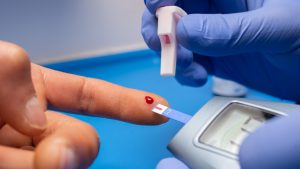Maintaining an active and healthy lifestyle at work is crucial for effectively managing diabetes and promoting overall well-being. Balancing a sedentary job with the demands of diabetes management presents unique challenges, but with the right strategies, it’s possible to stay active, manage glucose levels effectively, and foster healthy habits. In this blog, we’ll explore various strategies to incorporate physical activity and health into your daily work routine.
Benefits of an Active and Healthy Lifestyle at Work:
Staying active and adopting healthy habits at work not only improves diabetes management but also offers additional benefits such as:
- Improved Insulin Sensitivity: Regular physical activity can enhance insulin sensitivity, facilitating better blood glucose management.
- Stress Reduction: Physical exercise can reduce stress and improve mood, crucial aspects of emotional and physical well-being.
- Weight Management: Combining regular physical activity with a balanced diet helps maintain a healthy weight, which is essential for diabetes management.
Strategies for Maintaining an Active and Healthy Lifestyle at Work:
Incorporate Active Micro-breaks: Take short breaks to engage in activities like brief walks, stretching, or deep breathing exercises. These breaks can improve circulation and alleviate muscle tension.
Use Lunch Breaks Actively: Dedicate part of your lunch break to physical activities such as walking outdoors, practicing yoga, or doing full-body exercises in a designated area.
Opt for Active Transportation: Whenever possible, choose to walk, bike, or use public transportation to commute to work. This adds physical activity to your day and reduces stress from traffic.
Promote Movement in the Office: Take the stairs instead of the elevator, stand up and stretch your legs every hour if you work at a desk, and consider using a standing desk to alternate between sitting and standing throughout the day.
Organize Group Activities: Propose physical activities such as exercise classes, group walks, or yoga sessions for employees, promoting an active and supportive work environment.
Monitor and Adjust Activity Levels: Use activity tracking devices or mobile apps to monitor your daily activity levels and adjust your routine as needed to achieve your health goals.
Additional Tips:
Communicate Your Needs: Inform your employer about your diabetes management needs related to physical activity and health. This can help create a supportive work environment and support your efforts to maintain a healthy lifestyle.
Consult with Healthcare Professionals: Collaborate with your healthcare team to develop a personalized plan that integrates diabetes management, healthy diet, and appropriate physical activity for your specific situation.
Conclusion: Maintaining an active and healthy lifestyle at work with diabetes is achievable with planning and commitment. By incorporating simple yet effective strategies to increase physical activity and adopt healthy habits in the workplace, you can enhance diabetes management, reduce the risk of complications, and enjoy an improved overall quality of life.
References:
- American Diabetes Association. (n.d.). Exercise. Retrieved from https://www.diabetes.org/healthy-living/exercise
E4 Helps you:
At E4, we’re dedicated to revolutionizing how people manage type 2 diabetes through our innovative E4 Alive program. Our team of specialists has joined forces to create a comprehensive solution aimed at empowering individuals to take charge of their health journey. With personalized support and resources tailored to each person’s unique needs, we make managing diabetes simpler and more effective than ever before.
E4 Alive offers a range of tools and resources to help you better understand and control your blood sugar levels. Our program provides personalized guidance to create a healthy eating plan and integrate regular physical activity into your daily routine. Plus, you’ll have access to a supportive community of individuals who understand your challenges and are there to offer encouragement and guidance every step of the way.
By joining E4 Alive, you can effectively manage your blood glucose levels, improve long-term glycemic control, reduce your risk of diabetes-related complications, and enhance your overall quality of life. It’s not just a program; it’s an opportunity to reclaim your health and vitality. Ready to start your journey to better health? Visit THIS PAGE to learn more about E4 Diabetes Solutions and the E4 Alive program.
To learn more about E4 Diabetes Solutions and the E4 Alive program, visit THIS PAGE.

Type 2 Diabetes: Is It Really Reversible?
A recent National Geographic article [link] explores how type 2 diabetes could be reversible with the right approaches. This condition, which affects millions of people worldwide, has long been considered a chronic and progressive disease. However, recent research challenges this perception and suggests that with lifestyle changes and the right approach, remission is possible. The

How Do GLP-1 Drugs Compare? A Breakdown of Ozempic, Mounjaro, and Trulicity
GLP-1 receptor agonists have revolutionized diabetes management, with drugs like Ozempic, Mounjaro, and Trulicity leading the market. But how do these medications compare in terms of effectiveness, side effects, and patient outcomes? Let’s explore their differences and what they mean for diabetes patients. Understanding GLP-1 Medications GLP-1 receptor agonists mimic a natural hormone that helps

Why Has Medicare Spending on Diabetes Medications Skyrocketed in 5 Years?
In the past five years, Medicare spending on diabetes medications has increased nearly fivefold, reaching $35.8 billion in 2023. This surge has been primarily driven by the growing use of GLP-1 drugs such as Ozempic, Mounjaro, and Trulicity. But what is behind this cost escalation, and how does it affect patients and the U.S. healthcare

The Gut Microbiota and Blood Sugar Control: A Hidden Connection
The human gut is home to trillions of bacteria that play a crucial role in digestion, immune function, and even metabolism. Recent research has revealed a fascinating link between the gut microbiota and blood sugar regulation, shedding light on how the balance of microbes in our intestines can influence diabetes risk and overall metabolic health.

The Dawn Phenomenon: Why Blood Sugar Rises While You Sleep
For many people with diabetes, waking up with high blood sugar levels can be frustrating—especially if they didn’t eat anything overnight. This early-morning spike in blood glucose is known as the Dawn Phenomenon, and it happens due to natural hormonal changes in the body. But why does it occur, and how can it be managed?

The Influence of Red Light on Blood: Can It Improve Diabetes?
Type 2 diabetes is a metabolic disease characterized by insulin resistance and elevated blood glucose levels. In the search for complementary alternatives to improve glycemic control, red light therapy has gained attention due to its potential to enhance circulation, reduce inflammation, and optimize cellular function. But what does science say about it? ✨ What is

